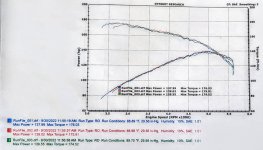mad_science
Well-known member
Just ran my 250-powered Ranchero in Lemons, but on Friday we had time to get it dyno-ed.
Figured it could be a useful benchmark for what you get from a build.
The specs:
Results, at the wheels:
140hp @ 5000
175lbft @ 2600-2700
(see attached)
At 10% drivetrain loss, that's 156 crank
15% --> 164 crank
20% --> 175 crank
It makes sense in a way because the Sniper is rated to support 300-350hp and at max RPM we were running the injectors at about 50% duty cycle.
Honestly it's more than I thought we'd get but also basically on par with a mediocre V8.
Figured it could be a useful benchmark for what you get from a build.
The specs:
- 250 D5DE block, standard bore
- 255 V8 pistons
- D3 Head opened up for 2V conversion, decked level but not milled down. Combustion chambers measure 62cc.
- Clay smith 274/274 108 LSA cam
- ^^^Based on my calculations this gives a static CR of 9.58:1 and a dynamic CR of 8.47:1
- Holley Sniper 2300 TBI EFI system kinda sorta tuned, but far from completely dialed in
- eBay HEI distributor, plugs gapped like 35-40thou
- Long tube headers running through dual 2.5" exhausts + glass packs
- Toploader 4 speed, 3.55:1 8" diff
- 205-50-R15 Falken Azenis tires on aluminum wheels
Results, at the wheels:
140hp @ 5000
175lbft @ 2600-2700
(see attached)
At 10% drivetrain loss, that's 156 crank
15% --> 164 crank
20% --> 175 crank
It makes sense in a way because the Sniper is rated to support 300-350hp and at max RPM we were running the injectors at about 50% duty cycle.
Honestly it's more than I thought we'd get but also basically on par with a mediocre V8.

